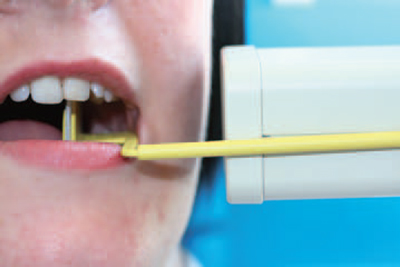SECTION 4
DIAGNOSTIC TECHNIQUES

REASON FOR PROCEDURE
When a patient attends a dental appointment for a dental examination, the dentist must check his or her oral health and determine the presence of caries, periodontal disease or oral soft tissue problems. Although the visual skills of the dentist are of paramount importance in identifying problems of the oral tissues, it is often necessary for diagnostic techniques to be implemented so that a definitive diagnosis can be made.
The three techniques to be discussed are:
- Use of dental hand instruments
- Dental radiographs
- Study models
USE OF DENTAL HAND INSTRUMENTS
Background information of procedure
A variety of dental hand instruments, called probes, have been designed to aid the dentist in detecting the presence of both caries and periodontal disease.
Those used to detect caries have sharp points that can be run over the tooth surface to find any softened areas of the enamel, which indicates that demineralisation has occurred and the area has undergone carious attack.
Those used to detect periodontal disease are blunt ended and have graded depth markings on them, so that the gums are not pierced during use and any gum pockets discovered can be depth recorded.
Details of procedure – dental caries
Frank carious cavities in teeth are easily visible to the dentist when they occur on uncovered and easily accessible surfaces of the teeth, but areas that are more difficult to examine require the use of dental probes. All have been designed so that their pointed ends are bent at various angles, enabling all surfaces of each tooth to be easily probed by the dentist.
Technique
- The patient is placed in the dental chair at a suitable angle for the dentist, with the dental inspection light providing good illumination when the mouth is open
- Visual examination is carried out first, so that any suspicious tooth surfaces are detected
- Each suspect area is then revisited and the probe end is run over the tooth surface
- A hard, scratchy surface indicates sound enamel
- A soft, non-scratchy surface indicates the presence of dental caries
- The dentist will be able to determine the presence of either by tactile sensation through the probe to the hand
Details of procedure – periodontal disease
Periodontal disease is often more difficult to detect by vision alone, as the gums of some patients will appear to be quite healthy and will exhibit no bleeding on touch. The presence of periodontal pockets alongside the tooth roots indicates that some destruction of the supporting tissues of the tooth has occurred – and the deeper the pocket, the more severe the destruction.
The pockets are not visible to the naked eye, but can be easily detected using a periodontal probe (see Figure 4.1).
Technique
- The patient is placed in the dental chair at a suitable angle for the dentist, with the dental inspection light providing good illumination when the mouth is open
- Visual examination is carried out first, including the identification of any tooth mobility
- Each suspect tooth–gum junction is then inspected for periodontal pocketing by ‘walking’ the blunt-ended probe around the gingival crevice
- A healthy gingival crevice will be no deeper than 2 mm and will not bleed when probed
- Where a periodontal problem exists, the probe will sink easily below the tooth–gum junction and the area will bleed on probing (see Figure 4.2)
- The probe may sink for several millimetres, and greater depths indicate more severe periodonta/>
Stay updated, free dental videos. Join our Telegram channel

VIDEdental - Online dental courses


